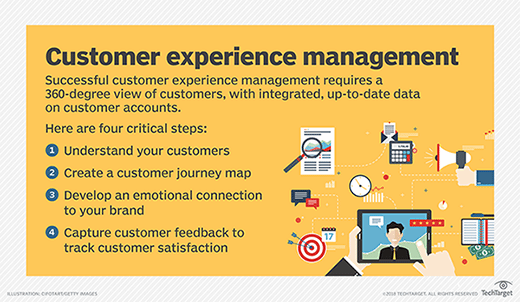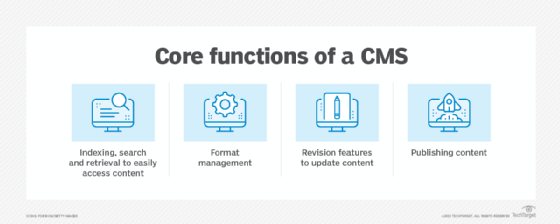digital experience (DX)
What is digital experience (DX)?
Digital experience (DX), also known as digital user experience (digital UX), is the take-away feeling an end user has after an experience in a digital environment or with a digital technology or device. Websites, mobile apps, social media sites, e-commerce sites, wearable devices and smart devices can all provide users with a DX.
A digital experience is what a user gets when they interact with an organization or application via one or more digital technologies. By itself, technology cannot drive DX, but a user's DX depends on how organizations use these technologies to improve customer experiences.
To that end, organizations create a DX strategy and design DX so it is relevant and personalized to the users they wish to attract and retain. Often, a DX design effort will take into consideration many different channels (omnichannel) to ensure that end users enjoy a great DX with that brand and its digital ecosystem, regardless of which digital channel or technology they use.

The importance of digital experience
DX is important because it is part of the overall user experience (UX) and customer experience (CX). For many users, their journey with a brand or organization starts or ends digitally. In general, DX is a major part of the brand journey for almost all users in both B2B and B2C settings. A poor DX can result in customers losing interest and perhaps even severing their relationship with the brand. Disappointed customers may also influence other customers who may, in turn, also abandon the brand.

To avoid customer churn and to boost customer retention (and acquisition), companies should create and deliver relevant, contextual and intelligent digital CX that addresses user needs and resonates with each user in a personalized manner. Focusing on DX and DX design helps businesses connect with their target audience, engage with prospective and current customers, improve user satisfaction and even enhance stakeholder experiences (e.g., employee experiences). In addition, personalized and high-quality DX can be a crucial competitive advantage and revenue driver. It can also secure customer loyalty and brand recognition and advocacy.
The expanding scope of digital experience
Traditionally, DX was the province of web designers and web content management. In addition, designers and content managers focused mainly on aspects such as the colors, layout, navigability and performance of a webpage to improve a user's DX.
Today, these elements still drive and influence DX, but other elements also play a key role in DX, including the following:
- how intuitive a page or mobile app is;
- how efficiently users can complete actions (e.g., how many clicks or swipes are required); and
- how well integrated an app or page is with other applications.
As the sophistication of online environments has grown and diversified beyond a webpage, the scope of DX has also broadened. Now DX also encompasses other digital channels, devices and applications, such as wearable computers, mobile apps, virtual assistants, software and applications that incorporate virtual reality and augmented reality components. In addition to multiple physical entities, DX should also be concerned with usability considerations from the perspective of a user having many devices and possibly multiple identities in their consumer and professional lives.
Digital experience platforms
Digital experience management can be a challenging endeavor, especially in omnichannel environments. A digital experience platform (DXP) can simplify the effort, enhance operational effectiveness and improve the productivity of DX teams. A DXP provides an integrated set of tools that enable organizations to design, manage, deliver and optimize DX for their customers and users across omnichannel or multichannel environments. It helps businesses to accelerate digital transformation initiatives and deliver rich omnichannel DX to every user.
By using a DXP, companies can deliver useful content across multiple touchpoints to their users, which may include the following:
- website
- mobile app
- social media pages
- e-commerce site
- point of sales (POS) systems
- IoT devices
- smart devices
- digital signage
This content on all those channels plays a key role in improving a user's DX with that brand. In addition to content dissemination, a DXP also helps with marketing automation. It can collect user data and feedback that may provide organizations with a better understanding of their users. Accordingly, they can create content that will resonate with these users and deliver unique and on-brand DX to increase interest and loyalty. Companies that use a DXP are better able to design and deliver consistent DX to their target customers and lead these customers toward a particular outcome.
Key components of digital experience platforms
Since content creation and dissemination is an important function of DXPs, most DXPs include a content management system (CMS) for creating and managing website content. Some DXPs also include capabilities for digital asset management (DAM), which streamlines the creation, storage, retrieval and distribution of visual content (e.g., images and video) across various channels.
Advanced DXPs offer AI-assisted analytics to collect and visualize customer data, generate insights from the data and use the insights to improve DX and CX. AI-based DXPs can also automate processes and create DXs that feel natural to customers and other users.
Some platforms include customer communication management (CCM) features to create, deliver, store and retrieve outbound customer communications across multiple channels, such as email, SMS and web, for various purposes, including marketing, payment notifications, new product introductions, renewal notifications and so forth.

Other tools to drive and improve digital experiences
In addition to DXPs, companies can use other tools to deliver personalized and memorable DX to their users, such as a customer data platform (CDP). A CDP is software that collects customer (or user) data from a wide range of sources to help organizations build a comprehensive and coherent view of each customer. Its main purpose is to enable companies to better understand their users and their needs, and accordingly develop personalized customer experiences that will attract and retain more customers.

Another important tool is a digital twin. A digital twin is a virtual representation of a system that allows businesses to simulate and analyze customer journeys and design more personalized DX and CX. A CMS (if it's not already part of the DXP) provides a unified way to create content that can then be distributed to numerous digital channels. Centralization simplifies the task of content creation and omnichannel distribution. It also enables marketing, sales, CX, customer support and other teams to track customer engagement across various channels in the omnichannel stack.






